FEATURE ARTICLE - CHANGES TO LABOUR FORCE SURVEY SEASONAL ADJUSTMENT PROCESSES
FEATURE ARTICLE - EMPLOYMENT IN INFORMATION AND COMMUNICATION TECHNOLOGY
FEATURE ARTICLE - LABOUR FORCE PARTICIPATION: INTERNATIONAL COMPARISON
FEATURE ARTICLE - POPULATION, PARTICIPATION AND PRODUCTIVITY - CONTRIBUTIONS TO AUSTRALIA'S ECONOMIC GROWTH
Notes
Changes in this issue
Table 5.1 has been modified to include trend Wage Cost Index data at the Australia level and for public and private sectors. Trend Wage Cost Index data has replaced original data in the Labour Market Summary. See 'Labour Statistics News' below for more details.
Data contained in this issue
The statistics shown are the latest available at 12 December 2003. Data sources for the tables in this publication are listed in Appendix 1.
Electronic products
The spreadsheets and data cubes referenced in this publication are available on the ABS web site at https://www.abs.gov.au. Follow the links to [Data cubes] and [Time Series Spreadsheets].
Inquiries
For further information about these and related statistics, contact the National Information and Referral Service on 1300 135 070 or Erika Maxim on Canberra 02 6252 7636.
Labour Market Summary
Key measures
Employment: trend series
Full-time and total employment
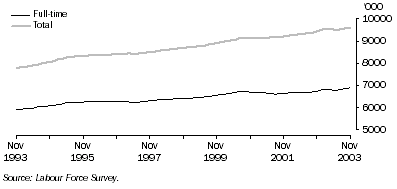
Males and females
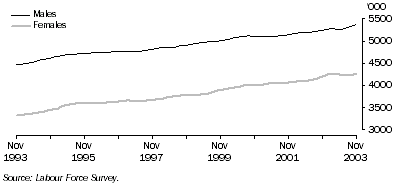
Part-time employment: trend series
Proportion of total employment, Males
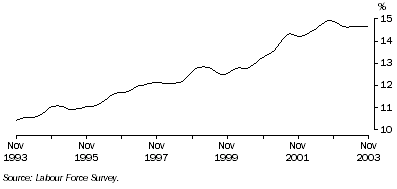
Proportion of total employment, Females
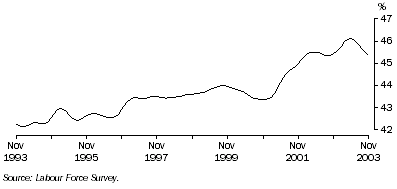
Unemployment rate: trend series
Males and females

Long-term unemployment: trend series
Proportion of total unemployment

Underutilised labour
Labour underutilisation rates—1994–2002
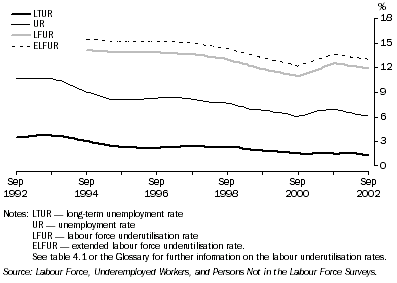
Participation rate: trend series
Wage cost index: trend series
Total hourly rates of pay excluding bonuses, Quarterly change
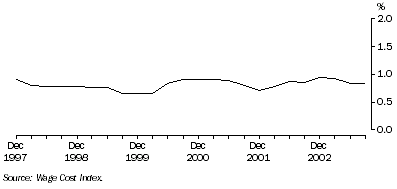
Average weekly earnings: trend series
Full-time adult ordinary time earnings, Quarterly change
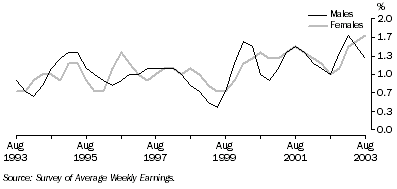
All employees total earnings, Level

Industrial disputes: original series
Working days lost, Quarter ending
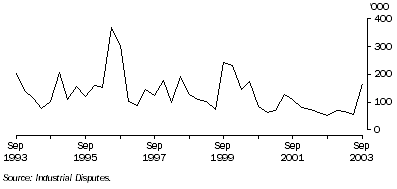
Job vacancies: trend series
Job vacancies, By sector

Labour statistics news
Labour theme page
The ABS Labour Theme Page, available on the ABS web site, provides a guide to the range of ABS statistics on the labour market, as well as links to the latest data released. To find the Theme Page, go to https://www.abs.gov.au (Themes - Labour).
Changes to Wage Cost Index publication
The experimental seasonally adjusted wage cost indexes previously published in Wage Cost Index, Australia (cat. no. 6345.0) as Appendix 2 are now considered as being of a suitable standard for ABS publication purposes and so the 'experimental' label has been removed. Trend series are also available. From the September quarter 2003 issue of 6345.0, the format of the publication and associated spreadsheets has changed to include the trend and seasonally adjusted indexes for total hourly rates of pay excluding bonuses for each of the private and public sectors and for all sectors.
As a result of these changes, table 5.1 of Australian Labour Market Statistics (cat. no. 6105.0) has been revised to include trend data alongside the original data. Revisions have also been made to the Labour Market Summary table and graphs, which now contain only trend Wage Cost Index data.
Format changes to initial release LFS products
The format of the publication Labour Force, Australia (cat. no. 6202.0), and other products associated with the initial release of monthly data from the LFS, will be changing from the November 2003 issue. These changes, including the revised layout of the publication, were detailed in the second issue of Information Paper: Changes to Labour Force Survey Products (cat. no. 6297.0), released on 23 October 2003.
LFS Standard Errors
Information Paper: Labour Force Survey Standard Errors (cat. no. 6298.0) was released on 15 December 2003. Accompanying the release of this paper was a spreadsheet that automates the process of calculating standard errors for most estimates produced from the Labour Force Survey. For more information see the Labour Theme Page at https://www.abs.gov.au (Themes - Labour - LFS Standard Errors).
Wage and salary earners electronic release
The June quarter 2003 issue of Wage and Salary Earners, Public Sector, Australia (cat. no. 6248.0) was the final release in the form of a printed publication. The publication will be replaced with a quarterly electronic publication under catalogue number 6248.0.55.001, containing a small number of summary tables, available free from the ABS web site https://www.abs.gov.au. More detailed tables are available in electronic format. The first issue of the new electronic publication (with reference period September quarter 2003) will be released on 15 January 2004.
Industrial disputes electronic release
The monthly publication Industrial Disputes, Australia (cat. no. 6321.0) will be replaced with a quarterly electronic publication under catalogue number 6321.0.55.001, commencing with the release of statistics for March quarter 2004. The electronic publication will contain a small number of tables presenting quarterly data and will be available free from the ABS web site at https://www.abs.gov.au. The December 2003 issue, which is scheduled for release on 18 March 2004, will be the final release in the form of a printed publication.
Review of ABS Working Arrangements Statistics
The ABS is conducting a review of working arrangements statistics. As part of the review, the ABS is consulting with users to find out more about their data needs. A discussion paper has been prepared to provide users with information about the purpose and scope of the review and some of the data issues that have been identified. The findings from the review will feed into the planning process for the household survey program and into the content of the relevant surveys.
Interested users of ABS working arrangements statistics are invited to read the discussion paper and provide their feedback by completing the questionnaire and returning it by 6 February 2004. The questionnaire and discussion paper are available at the Labour Theme page at https://www.abs.gov.au (Themes - Labour).
Understanding labour statistics course
In 2004, a one-day course on Understanding Labour Statistics will be conducted in each capital city for users of labour statistics. This one-day course will provide an overview of the range of concepts and issues associated with ABS labour statistics. It will explore the data produced by both household and employer based collections, and highlight the range of products available to access labour-related data. For more information about the course, see the Labour Theme Page, or contact Debbie Hansard on Canberra 02 6252 5895, or via email d.hansard@abs.gov.au.
Education and Work
Education and Work, Australia (cat. no. 6227.0) was released on 5 December 2003. See the article in this issue for more details.
Ageing in Australia
The National Ageing Statistics Unit released the publication Census of Population and Housing: Ageing in Australia, 2001 (cat. no. 2048.0) on 13 October 2003. This publication analyses the characteristics of the older population (persons aged 65 years and older) drawing on 2001 census data. Information is organised into seven chapters, by major areas of social concern: population; cultural diversity; living arrangements; work and economic environment; transport; education; and technology.
General Social Survey
Results from the 2002 General Social Survey were released on 18 December 2003 in the publication General Social Survey: Summary Results, Australia (cat. no. 4159.0). In addition, a data reference package, a user guide and state and territory data (cat. no. 4159.0.55.001 etc.) are due for release.
This survey brings together a wide range of information for various population groups and areas of social concern. Topics include: health; housing; education; work; income; financial stress; broad assets and liabilities; transport, family and community; and crime and justice.
Regional Wage and Salary Earner Statistics
The first issue of Regional Wage and Salary Earner Statistics, Australia - Electronic Publication (cat. no. 5673.0.55.001) was released on 19 December 2003. This electronic release contains estimates of the total number of wage and salary earners and their characteristics for various levels of the Australian Standard Geographical Classification (ASGC), including Statistical Local Areas (SLAs) and Local Government Areas (LGAs), in each state and territory of Australia for the year 2000-01.
The data have been compiled from aggregated data supplied from the Australian Taxation Office's Individual Income Tax Return Database, and are part of an ABS initiative to increase the range of regional statistics available, particularly through the use of administrative information held by other government agencies.
Health and Community Services Labour Force
Health and Community Services Labour Force, 2001, published jointly by the Australian Institute of Health and Welfare (AIHW) (cat. no. HWL 27) and the ABS (cat. no. 8936.0) on 30 September 2003, is the second in an AIHW series that presents health and community services workforce data from the Census. It includes information on the number, distribution and characteristics of employed persons in 105 occupations identified as providing health and community services in 2001, and discusses growth and other changes in this workforce since 1996.
Recent and upcoming statistical releases |
|  |
| Release date/title of publication |  | Reference period | Catalogue number |  |
|  |
| January 2004 |  |  |  |
 | Australian Labour Market Statistics | January 2004 | 6105.0 |  |
 | Australian Census Analytic Program: Factors Underlying Indigenous Labour Force Status, 1981-2001 | 2001 | 2052.0 |  |
 | Industrial Disputes, Australia | October 2003 | 6321.0 |  |
 | Job Vacancies, Australia | November 2003 | 6354.0 |  |
 | Labour Force, Australia | December 2003 | 6202.0 |  |
 | Wage and Salary Earners, Public Sector, Australia - electronic release | September quarter 2003 | 6248.0.55.001 |  |
| February 2004 |  |  |  |
 | Average Weekly Earnings, Australia | November 2003 | 6302.0 |  |
 | Employee Earnings, Benefits and Trade Union Membership, Australia | August 2003 | 6310.0 |  |
 | Industrial Disputes, Australia | November 2003 | 6321.0 |  |
 | Job Search Experience, Australia | July 2003 | 6222.0 |  |
 | Labour Force, Australia | January 2004 | 6202.0 |  |
 | Wage Cost Index, Australia | December quarter 2003 | 6345.0 |  |
| March 2004 |  |  |  |
 | Industrial Disputes, Australia | December 2003 | 6321.0 |  |
 | Labour Force, Australia | February 2004 | 6202.0 |  |
 | Persons Not in the Labour Force, Australia | September 2003 | 6220.0 |  |
 | Underemployed Workers, Australia | September 2003 | 6265.0 |  |
 | Wage and Salary Earners, Public Sector, Australia | December quarter 2003 | 6248.0.55.001 |  |
| April 2004 |  |  |  |
 | Australian Labour Market Statistics | April 2004 | 6105.0 |  |
 | Indigenous Social Survey, Australia | 2002 | 4714.0 |  |
 | Job Vacancies, Australia | February 2004 | 6354.0 |  |
 | Labour Force, Australia | March 2004 | 6202.0 |  |
 | Labour Statistics in Brief, Australia | 2004 | 6104.0 |  |
 | Workplace Functions in Regional Labour Markets, Queensland | 1976 to 2001 | 6601.3 |  |
|  |
 Print Page
Print Page
 Print All
Print All